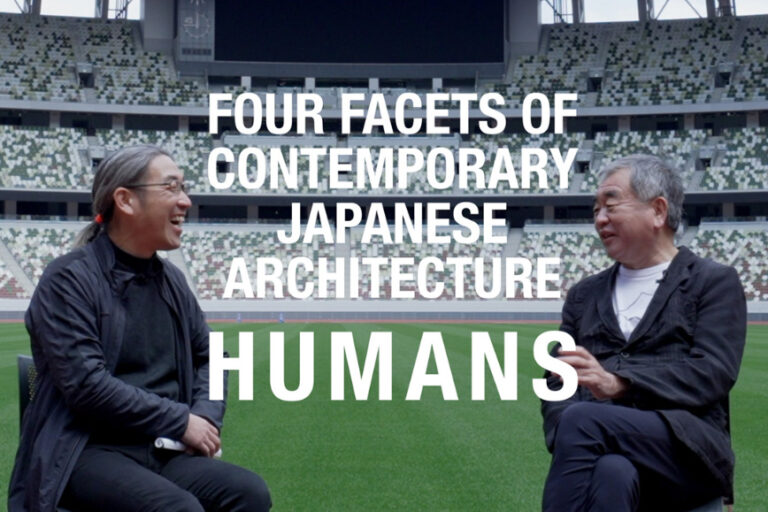”Four Facets of Contemporary Japanese Architecture” XSeries Program has started at edX.
During nearly 60 years between the two Tokyo Olympics, 1964 and 2021, how has architecture changed?

In this XSeries, you can take all four courses in the “Four Facets of Contemporary Japanese Architecture” series: “1st Facet: Theory,” “2nd Facet: Technology,” “3rd Facet: City,” and “4th Facet: Humans”. In the paid course [Verified Track], you will receive a certificate of completion by answering comprehension quizzes, but you can also view all lecture videos in the free course [Audit Track].
In this series, we have looked back on the turbulent half-century since Japan’s reconstruction after World War II, focusing on the four facets of architecture, together with the architects involved. We hope that many people will find it useful as a resource for considering the future of architecture and humanity.
Contents
FOUR FACETS OF CONTEMPORARY JAPANESE ARCHITECTURE: Theory
1-1. Revisiting Kenzo Tange, Yoyogi 1st Gymnasium (1964)
1-2. In Search of a Space – Arata Isozaki, The Museum of Modern Art, Gunma (1974)
1-3. Learning from Style – Hisao Kohyama, Sainokuni Saitama Arts Theater (1994)
1-4. New Primitivism – Terunobu Fujimori, La Collina Omihachiman (2014)
1-5. Connecting the Dots – Hidetoshi Ohno, Heart Nursery School (2014)
1-6. Architect without Architecture – Kengo Kuma, Asakusa Culture Tourist Information Center (2012)
1-7. Too Large As Architecture Too Small As City – Kazuyo Sejima, Inujima “Art House Project” (2010-)
1-8. Review – 1st Facet: Theory
FOUR FACETS OF CONTEMPORARY JAPANESE ARCHITECTURE: Technology
2-1. Architecture Lives Inside People – Tadao Ando, Atelier in Oyodo II (1991)
2-2. Advancing Systemic Spaces – Kazuhiko Namba, BOXHOUSE 112 (2006)
2-3. What Do You Want, Wood? – Shigeru Ban, La Seine Musicale (2017)
2-4. Why I Went to Countryside? – Kengo Kuma, Yusuhara Wooden Bridge Museum (2010)
2-5. Design by Reinterpretation – Manabu Chiba, KOGAKUIN UNIVERSITY 125TH MEMORIAL EDUCATION CENTER (2012)
2-6. In Praise of Errors – Yusuke Obuchi, DFL Pavilion (2015)
2-7. Review – 2nd Facet: Technology
FOUR FACETS OF CONTEMPORARY JAPANESE ARCHITECTURE: City
3-1. Architectures in Unconditional Love – Fumihiko Maki, Hillside Terrace (1969-1992)
3-2. Architecture for the People – Itsuko Hasegawa, Niigata City Performing Arts Center (1998)
3-3. Transparency: Literal & Behavioral – Riken Yamamoto, Saitama Prefectural University (1999)
3-4. Worldly Architecture – Kengo Kuma, Nagaoka City Hall Aore (2012)
3-5. Towards an Architecture of Emancipation – Jun Aoki, Omiyamae Gymnasium (2014)
3-6. architecture After Architecture – Atelier Bow-Wow, Koisuru-Buta Laboratory (2012)
3-7. Review – 3rd Facet: City
FOUR FACETS OF CONTEMPORARY JAPANESE ARCHITECTURE: Humans
4-1. Architecture is Fiction – Hiroshi Hara, Hara House (1974)
4-2. Constructing From Subconscious Images – Toyo Ito, Toyo Ito Museum of Architecture, Imabari (2011)
4-3. Towards an Architecture of Interiority – Osamu Ishiyama, Gen An (1975)
4-4. Living Room of the City – Kengo Kuma, V&A Dundee (2018)
4-5. A House for Living Together – Satoko Shinohara, SHARE yaraicho (2012)
4-6. Respect the World – Sou Fujimoto, SHIROIYA HOTEL (2020)
4-7. Review – Kengo Kuma & Yusuke Obuchi, Japan National Stadium (2019)In this XSeries, you can take all four courses in the “Four Facets of Contemporary Japanese Architecture” series: “1st Facet: Theory,” “2nd Facet: Technology,” “3rd Facet: City,” and “4th Facet: Humans”. In the paid course [Verified Track], you will receive a certificate of completion by answering comprehension quizzes, but you can also view all lecture videos in the free course [Audit Track].
In this series, we have looked back on the turbulent half-century since Japan’s reconstruction after World War II, focusing on the four facets of architecture, together with the architects involved. We hope that many people will find it useful as a resource for considering the future of architecture and humanity.
Technology
2-1. Architecture Lives Inside People – Tadao Ando, Atelier in Oyodo II (1991)
2-2. Advancing Systemic Spaces – Kazuhiko Namba, BOXHOUSE 112 (2006)
2-3. What Do You Want, Wood? – Shigeru Ban, La Seine Musicale (2017)
2-4. Why I Went to Countryside? – Kengo Kuma, Yusuhara Wooden Bridge Museum (2010)
2-5. Design by Reinterpretation – Manabu Chiba, KOGAKUIN UNIVERSITY 125TH MEMORIAL EDUCATION CENTER (2012)
2-6. In Praise of Errors – Yusuke Obuchi, DFL Pavilion (2015)
2-7. Review – 2nd Facet: Technology
FOUR FACETS OF CONTEMPORARY JAPANESE ARCHITECTURE: City
3-1. Architectures in Unconditional Love – Fumihiko Maki, Hillside Terrace (1969-1992)
3-2. Architecture for the People – Itsuko Hasegawa, Niigata City Performing Arts Center (1998)
3-3. Transparency: Literal & Behavioral – Riken Yamamoto, Saitama Prefectural University (1999)
3-4. Worldly Architecture – Kengo Kuma, Nagaoka City Hall Aore (2012)
3-5. Towards an Architecture of Emancipation – Jun Aoki, Omiyamae Gymnasium (2014)
3-6. architecture After Architecture – Atelier Bow-Wow, Koisuru-Buta Laboratory (2012)
3-7. Review – 3rd Facet: City
FOUR FACETS OF CONTEMPORARY JAPANESE ARCHITECTURE: Humans
4-1. Architecture is Fiction – Hiroshi Hara, Hara House (1974)
4-2. Constructing From Subconscious Images – Toyo Ito, Toyo Ito Museum of Architecture, Imabari (2011)
4-3. Towards an Architecture of Interiority – Osamu Ishiyama, Gen An (1975)
4-4. Living Room of the City – Kengo Kuma, V&A Dundee (2018)
4-5. A House for Living Together – Satoko Shinohara, SHARE yaraicho (2012)
4-6. Respect the World – Sou Fujimoto, SHIROIYA HOTEL (2020)
4-7. Review – Kengo Kuma & Yusuke Obuchi, Japan National Stadium (2019)
Online courses from The University of Tokyo:











